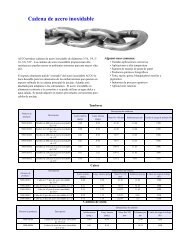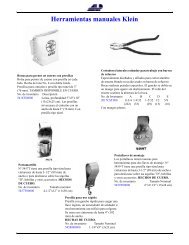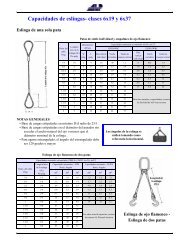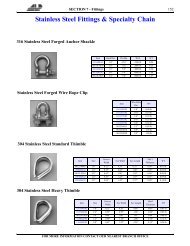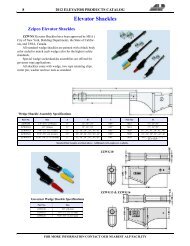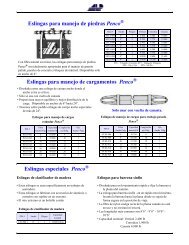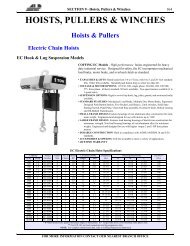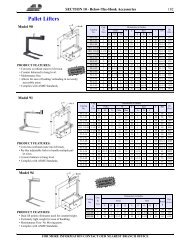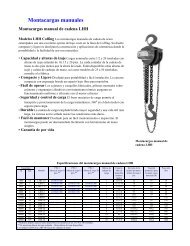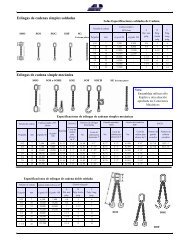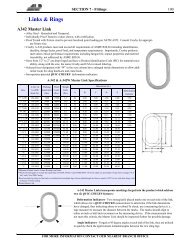General Products - ALP Industries Inc.
General Products - ALP Industries Inc.
General Products - ALP Industries Inc.
- No tags were found...
Create successful ePaper yourself
Turn your PDF publications into a flip-book with our unique Google optimized e-Paper software.
SECTION 1 - Wire Rope 4Wire Rope InspectionThe most widely used wire rope replacement, inspectionand maintenance standard for mobile-type cranes is ASMEB30.5, section 5-2.4. The following is an excerpt from thatstandard.All running ropes in service should be visually inspectedonce each working day. A visual inspection shall consist ofobservation of all rope which can reasonably be expected tobe in use during the day’s operations. These visual observationsshould be concerned with discovering gross damage,such as listed below which may be an immediate hazard:[A] Distortion of the rope such as kinking, crushing,unstranding, birdcaging, main strand displacement, or coreprotrusion. Loss of rope diameter in a short rope length orunevenness of outer strands should provide evidence that therope must be replaced.[B] <strong>General</strong> Corrosion[C] Broken or Cut strands[D] Number, distribution, and type of visible broken wires[E] Core failure in rotation resistant ropes: when suchdamage is discovered, the rope shall be either removed fromservice or given an inspection (further detail per S-2.4.2).The frequency of detailed and thorough inspections shouldbe determined by a qualified person, who takes into accountthe following factors:• Expected rope life as determined by [a] maintenancerecords, and [b] experience on the particular installationor similar installations• Severity of environment• Percentage of capacity lifts• Frequency rates of operation, and exposure to shock loadsInspect the entire length of the rope. Some areas of thewire rope such as around the core are more difficult toinspect. To inspect the core, examine the rope as it passesover the sheaves. The strands have a tendency to open upslightly which will afford the inspector a better view of thecore. Also regularly inspect for any reduction in diameterand lengthening of rope lay as both conditions indicate coredamage.Basic GuidelinesAbrasion Abrasion damage may occur when the rope contactsan abrasive medium or simply when it passes over thedrum and sheaves. Therefore it is vital that all componentsbe in proper working order and of the appropriate diameterof the rope. A badly corrugated or worn sheave or drum willseriously damage a new rope, resulting in premature ropereplacement.Corrosion Corrosion is very difficult to evaluate but is amore serious cause of degradation than abrasion. Usuallysignifying a lack of lubrication, corrosion will often occurinternally before there is any visible external evidence on therope’s surface. A slight discoloration caused by rusting usuallyindicates a need for lubrication which should be tendedto immediately. If this condition persists, it will lead tosevere corrosion which promotes premature fatigue failuresin the wires and strands, necessitating the rope’s immediateremoval from service.Wire Breaks The table below shows the number of allowablewire breaks per crane type. The inspector must knowthe ASME standard for the equipment being inspected. Thenumber of broken wires on the outside of the wire rope is anindication of its general condition and whether or not it mustbe considered for replacement. The inspector may use a typeof spike to gently probe the strands for any wire breaks thatdo not protrude. Check as the rope runs at a slow speed overthe sheaves, where crown (surface) wire breaks may be easierto see. Also examine the rope near the end connections.Keeping a detailed inspection record of the wire breaks andother types of damage will help the inspector determine theelapsed time between breaks. Note the area of the breaksand carefully inspect these areas in the future. Replace therope when the wire breaks reach the total number allowableby ASME or other applicable specifications.ASMENo.EquipmentNo. BrokenWries in RunningRopes inOne RopeLayOneStrandNo. BrokenWries in StandingRopes inOneRopeLayOneStrandB30.2 Overhead and Gantry Cranes 12* 4 N/A N/AB30.4 Portal, Tower and Pillar Cranes 6* 3 3* 2B30.5 Crawler, Locomotive & Truck Cranes 6* 3 3* 2B30.6 Derricks 6* 3 3* 2B30.7 Base-Mounted drum Hoists 6* 3 3* 2B30.8 Floating Cranes & Derricks 6* 3 3* 2A10.4 Personnel Hoists 6* 3 2* 2A10.5 Material Hoists 6* N/A N/A N/A* Also remove for ONE valley break. OSHA require monthly record keeping of wirerope conditions. NOTE: current industry recommendations and OSHA standards arebased upon steel sheaves. The manufacturer of plastic and synthetic sheaves or linersshould be consulted for its recommendation on the safe application of the product andinspection criteria.Valley breaks, or breaks in between strands, must be takenvery seriously at all times! When two or more valleybreaks are found in one lay-length, immediately replacethe rope. Valley breaks are difficult to see; however, if yousee one you can be assured that there are a few more hiddenin the same area. Crown breaks are signs of normal deterioration,but valley breaks indicate an abnormal condition suchas fatigue or breakage of other wires such as those in thecore.Once crown and valley breaks appear, their number willsteadily and quickly increase as time goes on. The brokenwires should be removed as soon as possible by bending thebroken wire back and forth with a pair of pliers. In this waythe wire is more likely to break inside the rope where theFOR MORE INFORMATION CONTACT OUR NEAREST BRANCH OFFICE





